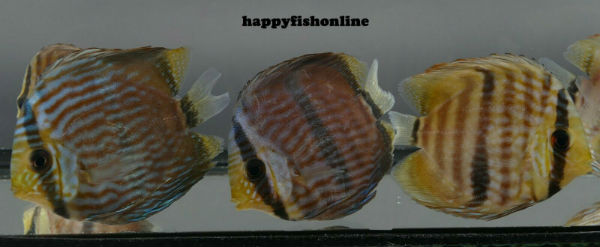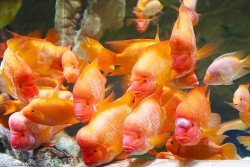Heckel Discus fish for sale online from Rio Negro Brazil with direct shipping
 Undoubtedly the most respected and desirable of all Cichlids, and indeed all aquarium fishes, is the Discus, Symphysodon, often referred to as the King of aquarium fishes. Since their introduction in 1933 the keeping and breeding of Discus fishes has been the ambition of many fishkeepers throughout the world. Oddly enough though the first Discus species were described by Dr. Johann Heckel in 1840 but did not attract much attention.
Undoubtedly the most respected and desirable of all Cichlids, and indeed all aquarium fishes, is the Discus, Symphysodon, often referred to as the King of aquarium fishes. Since their introduction in 1933 the keeping and breeding of Discus fishes has been the ambition of many fishkeepers throughout the world. Oddly enough though the first Discus species were described by Dr. Johann Heckel in 1840 but did not attract much attention.The Discus fish's natural habitat is the Amazon region of South America, and there is controversy in the fish keeping world regards the classification of this fish. One school of thought is that all Discus should be grouped together, while some ichthyologists believe that the Discus is actually two species, the common Discus being Symphysodon aequifasciatus, and the Heckel or Red Discus being Symphysodon discus, with the two species being divided into a total of five subspecies. It is not my aim to influence anyone's thoughts on the subject either way, as I have mentioned before, fishkeepers usually have their own opinions about various aspects of the hobby.
There has been many specialist books published about the Discus, and I would recommend that you read at least one of them if you are serious about keeping Discus, and I will give a general overview of the Discus.
If preference for the two-species classification is to be expressed, then the following is a simplified suggestion for the species and varieties of the Discus fish. One thing is for certain though, whatever species or variety we deal with, color will change with environment. Merely adjusting the pH and hardness of the aquarium water can bring about changes from brown to red and brown to green. It has also been observed that color changes can occur through diet; broods of "Brown" fed an exclusive diet of daphnia pulex, for example, attain red body coloration. It should be appreciated then that it is extremely difficult to identify Discus by color or pattern. It should also be noted that young fishes give no indication as to their eventual colour when adulthood is attained.
Symphysodon aequifasciata
This species can be recognised initially by the nine vertical bars that are evident along the body. There are numerous varieties, many named after the person that discovered or developed that particular strain.
The common Brown Discus Symphysodon aequifasciatus axelrodi (Schultz) from around the mouth of the River Amazon, is recognized by it's brown background and blue stripes, which extend through the head, as well as the anal and dorsal fins, which are edged in red. It is named after Dr. Herbert R. Axelrod, who has made numerous contributions to the hobby by way of research on this subject, and books on Aquariology.
The Red Discus has a reddish brown background and is a more colorful variety of the Brown Discus. Its fins are brilliant red, and this discus was sometimes referred to as the "Red Gypsy". They were bred in Germany, but the first specimens came from around the border of Peru and Brazil.
The Green Discus supports two varieties; one from Lake Tefe near the Amazon, hence the name, Tefe green, which has a dark red-brown to golden background. The second, and the hardiest of all wild discus, is the Peruvian green, which is less colorful, this too has a background color of red-brown to gold, with a red edging to the fins and red spots throughout the body.
Other color varieties of S. aequifasciatus include:
The Blue Discus, with additional horizontal blue veining and general blue body colouration.
The Rainbow, or Seven-color Discus, has additional yellow in the body, and yellow, red and blue in the dorsal and anal fins.
The Heckel Discus Symphysodon discus (Heckel) originates from the soft, acid waters of the River Negro, Brazil. As mentioned previously, it was in 1840 that Dr. Johann Heckel first made this fish known to the world.
The "Heckel" is easily distinguished from the Brown (and its varieties) by the overall blue and red horizontal veining, which have a wavy irregular pattern that start behind the operculum (gill cover) and end at the caudal fin. Unlike S. aequifasciatus, where the nine vertical bars are easily visible, Heckel has three that are very dominant, whereas the other six are almost invisible. The bars that are visible run through the eye, the middle body, and the caudal fin.
Crosses of the species are more readily available because "pure" Heckels rarely spawn in captivity. Confusion also arises due to certain South American exporters using the term Blue Discus in describing the fish, whereas English importers use the term Red Heckel. There is also a green color variety of the Heckel, which derives from the horizontal veining, which is lighter than the normal blue.
Symphysodon aequifasciatus axelrodi (Schultz) from around the mouth of the River Amazon, is recognized by it's brown background and blue stripes, which extend through the head, as well as the anal and dorsal fins, which are edged in red. It is named after Dr. Herbert R. Axelrod, who has made numerous contributions to the hobby by way of research on this subject, and books on Aquariology.
Symphysodon discus originates from the soft, acid waters of the River Negro, Brazil. The "Heckel" is easily distinguished from the Brown (and its varieties) by the overall blue and red horizontal veining, which have a wavy irregular pattern that start behind the operculum (gill cover) and end at the caudal fin. Unlike S. aequifasciatus, where the nine vertical bars are easily visible, Heckel has three that are very dominant, whereas the other six are almost invisible. The bars that are visible run through the eye, the middle body, and the caudal fin.




